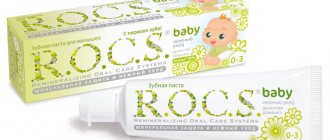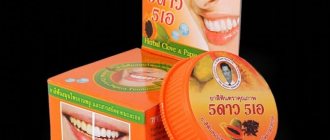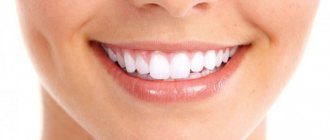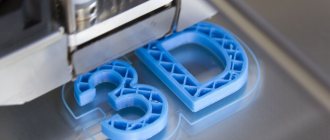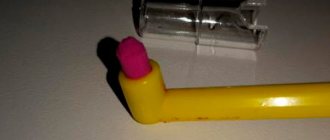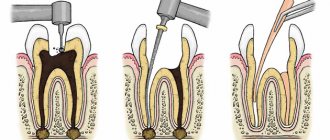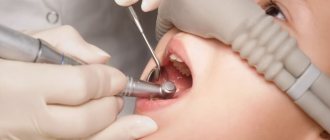Our enamel is constantly exposed to aggressive external factors, such as coloring products, coffee and tea, medications, and tobacco smoke. All this over time leads to a gradual change in the color of the teeth, the formation of abundant yellow plaque, which over time turns into hardened deposits that provoke the development of caries. Today, the Vita tooth color scale is actively used in dentistry - it is used to determine the shade of enamel, predict the results of whitening, and select the appropriate tone for filling materials. Later in this article we will talk about what this scale is, when it is used and how to use it correctly.
What factors determine the natural color of enamel?
Before moving on to the technique of using the Vita scale in dentistry, let’s consider what the natural shade of teeth depends on and what affects their color. Several factors play a decisive role in this issue, and here are the main ones:
- heredity,
- predisposition to certain systemic pathologies,
- level of hygiene,
- diet,
- condition and strength of bone tissue.
If we talk about what tone of teeth is considered normal, then we must immediately make a reservation that the enamel consists of approximately 97% of inorganic compounds. Therefore, its natural color is different for everyone, despite the fact that a person may not have any pronounced dental problems.
Heredity primarily determines the color of teeth
A change in the color of the enamel, its yellowing should be a good reason for concern and contact a specialist. After all, poor hygiene and plaque are not the only reasons for visible changes, and the real problem may lie much deeper. The reason may be not only dental disease, but also systemic pathologies.
For what reasons can the shade of teeth change?
A naturally perfect snow-white smile is quite rare. In addition to the fact that most people’s teeth have a slight yellowish tint from birth, throughout their lives they are constantly exposed to external factors that cause their color to change. Here are just the main prerequisites:
- improper and irregular cleaning,
- addiction to coffee, strong tea and other coloring drinks,
- smoking cigarettes,
- aging of the body,
- dental diseases,
- consumption of products with intense coloring pigments,
- lack of vitamins and microelements or their excess in the body,
- taking certain medications.
Constant exposure to external factors causes changes in the color of teeth
. To maintain the natural whiteness of a smile, you need to follow the rules of oral hygiene, respond in time to any suspicious changes, and regularly visit the dentist’s office for preventive examinations.
Review of modern technologies for determining the color of a patient’s teeth in a dental clinic
Tags: Color selection
Recently, scientists have developed a fairly large number of theories for determining the color of teeth. Each of them reflects a number of environmental, temporal and physiological factors that influence the mechanism of visual perception of a dentist.
The following factors are of great importance in determining the color of teeth:
- Light source;
- Light level of the tooth;
- Reflected light-reflex;
- Color adaptation;
- Interpretation of color.
Even if all people had the same retinal structure, color perception would remain subjective due to differences in color perception abilities. The most important condition for achieving success is close cooperation between the dentist and the patient. With the help of modern technologies, it is possible to obtain useful additional information, for example, to determine the color of the patient’s teeth not only visually, but also using digital technology. Visual technologies for determining tooth color are a subjective process and require certain knowledge and skills, optimal conditions, and also depend on individual characteristics, such as color perception and visual acuity.
COLOR VITA CLASSICAL (VITA ZAHNFABRIK)
VITA coloring has 16 colors, divided into four tone ranges: A, B, C, D ( Fig. 1 ):
- A – orange-brown;
- B – yellow-orange;
- C – gray-brown;
- D – orange-gray.
Rice. 1
In real life, one of the colors may predominate over the others, for example, A3 with a predominance of orange, or A3.5 - more saturated, but not A4. The neck of a natural tooth, as a rule, is colored more intensely because it is the thinnest layer of enamel, which must be taken into account when determining the color. Sometimes the color of the neck of the tooth may be in a tone different from the main one. For example, the main tone may be A, but the neck of the tooth may be yellow with a range of B. For the aesthetic appearance of the restoration, the brightness indicator plays the most important role. The VITA coloring comes with an insert where the colors are arranged according to brightness: B1, A1, B2, D2, A2, C1, C2, D4, A3, D3, B3, A3.5, B4, C3, A4, C4. You can often see teeth that have a tone A or B, but at the same time, their brightness is quite similar to the C range. That is, if you apply one of the teeth of color group C to such a tooth with reduced brightness, you will see that it (the tooth from the color) will hardly stand out. The teeth will be identical in brightness, and the only difference will be in color. An error in brightness instantly highlights the restoration in the oral cavity. A difference in color or saturation is sometimes not as noticeable as an error in brightness.
COLOR VITA SYSTEM 3D-MASTER (VITA ZAHNFABRIK)
The VITA SYSTEM 3D-MASTER color system developed by the company’s specialists is based on the principles of colorimetry (lightness, saturation and hue) and consists of 26 colors. It managed to systematize all possible shades of the color of a living tooth and arrange them into a scale that is simple and convenient for doctors and technicians to use ( Fig. 2–3 ). Although the perception of colors is always subjective, colors are nevertheless, from a physical point of view, distributed along the spectrum in a three-dimensional spherical model based on three basic characteristics of color.
Rice. 2
Rice. 3
- Determination of lightness (L – Lightness)
All teeth standards on the scale are divided into five lightness groups. In each individual group, the standards differ in color saturation and hue, but have the same lightness parameter. At the first stage, only lightness is determined, i.e. you need to choose not one of 26 standards, but determine one of five groups by lightness.
- Determination of saturation (C – Chroma)
In the previously selected lightness group, the middle bar is taken and fanned out. All standards on the bar are of the same shade and lightness. Of these, you need to choose one that is most suitable in terms of saturation.
- Determination of hue (H – Hue)
The need for this stage will arise if the patient’s tooth still differs from the selected standard towards a yellowish or reddish tint. Then you need to select one of the standards with the designation L (yellowish) or with R (reddish) all in the same lightness group and clarify the color coding: instead of the designation M there will be L or R. This completes the choice of color.
CHROMASCOP COLOR (IVOCLAR VIVADENT)
The Chromascop shade is a practical, universal shade. It consists of 20 colors, which are divided into 5 visual, removable color groups ( Fig. 4) :
- 110–140 – white
- 210–240 – yellow
- 310–340 – light brown
- 410–440 – gray
- 510–540 – dark brown
Rice. 4
After determining the main shade, further color determination operations are carried out only within the corresponding group. Consistent rejection of unnecessary effects when designing the Chromascop shade (for example, the image of the neck, transparent areas, strong color changes in the area of the incisal edge and dentin, as well as surface coloring) makes it much easier to determine the shade of the tooth. The main advantage of this color is its wide range of applications. Unfortunately, determining the color of teeth using a standard shade scale (visual technologies) does not always give a real picture, because teeth, like any other creation of nature, are very multicolored (multichrome). Digital technologies for determining the color of natural teeth, unlike visual technologies, do not depend on the subjective opinion of the doctor and the color shades of the environment. The essence of these technologies is an objective computer analysis of the image obtained under ideal optical conditions, then based on it, a high-quality map of tooth shades is compiled, indicating transparency.
SPECTROMETER SHADEPILOT (DEGUDENT)
The Shadepilot spectrometer from DeguDent provides an opportunity to significantly improve the accuracy of color determination, the objectivity of the information received, and eliminate the influence of subjective factors on the results of work. According to DeguDent specialists, in the future color determination will become exclusively digital. Shadepilot combines various digital capabilities: high-quality image production and digital processing, a wide variety of additional options, ease of use. With its help, you can evaluate all the basic color parameters: shades, brightness, saturation and transparency. Allows you to accurately analyze the spectral composition of color. The analysis results do not depend on the type of lighting fixtures installed in the room or other lighting conditions.
SHADESCAN DEVICE (CYNOVAD)
The ShadeScan device from CYNOVAD allows you to obtain a full range of information about tooth color. The operating principle is based on color analysis of digital photographs. The device allows you to evaluate all the most important parameters of tooth color: shades (according to various palettes), intensity, brightness and transparency, as well as its shape. The measurement technique is based on the principle of artificial vision, which, according to the manufacturer, is as close as possible to the mechanism of human color perception. Thanks to the integrated light source, measurement results are independent of external lighting conditions, which significantly increases their objectivity. In principle, the use of this device allows the correct selection of shades to be made without direct contact between the patient and the dental technician. In addition, the ability to store data on a flash card greatly facilitates the exchange of information between the clinic and the dental laboratory.
SHADEEYENCC DEVICE (SHOFUDENTAL)
The ShadeEyeNCC device from ShofuDental determines the exact composition of the color and adapts the results to the palettes of 5 standard color systems. The built-in memory is designed to store up to 100 measurement protocols, so this device can be used as a mobile measuring center. Using an infrared port, the results obtained are easily transferred to a PC, from which they can be saved to any storage medium and sent by e-mail. The software complements and expands the native capabilities of the measuring device. With its help, you can create a three-dimensional color picture of a natural tooth, consisting of 256 shades.
VITA EASYSHADE (VITA ZAHNFABRIK)
The VITA Easyshade is a spectrophotometer for intraoral use and shade determination according to the VITA Classical and VITA 3D-Master systems, and is therefore ideal for shade selection of restorations made from the wide range of VITA ceramic materials. The working part contains a special fiber-optic probe for lighting and recording the color of teeth, several spectrometers and one microprocessor for communication with the electronic unit ( Fig. 5 ).
Rice. 5
DEVICE (SMILE LINE)
Inspired by the work of renowned lecturers and clinicians, including L. Vanini (1996) and S. Papazoglou (2016), together with the Styleitaliano team (a group of passionate researchers and clinicians - www.styleitaliano.org), Smile Line has released a special polarizing filter that neutralizes the surrounding artificial and natural lighting (Fig. 6) .
Rice. 6
Also, due to the neutralization of light, the shine partially disappears from the surface of the teeth, and the process of determining color is greatly simplified. The light temperature of the device is 5500°K, which corresponds to natural daylight. In addition to the SMILE LITE device, Smile Line offers its new revolutionary Smile Line MDP device, which allows you to take excellent professional dental photographs directly from your smartphone. Smile Lite MDP, which can be called a “mini photo studio,” has undergone three years of development and testing (Fig. 7–8) .
Rice. 7
Rice. 8
The device is equipped with three groups of LEDs. Each of these groups produces its own individual lighting, and you have the ability to adjust the lighting power using a dimmer switch (four different power levels are provided). The back cover of Smile Lite MDP is equipped with a universal adapter that is compatible with any smartphone with a width of 55–58 mm. Determining color in modern dentistry is an important task, the solution of which is aimed at restoring the aesthetic appearance of the entire oral cavity, improving the appearance of the patient, and, in addition, may contribute to improving overall health by gaining a sense of self-confidence. Determining color is a rather labor-intensive and complex process that requires professionalism from the dentist and careful adherence to the rules for determining color in order to eliminate inaccuracies as much as possible. However, the automated method cannot replace traditional methods. Digital technologies for determining the color of natural teeth should be a mandatory element in addition to visual assessment.
SOURCE: Digital Dentistry Magazine
Similar articles:
Akulovich Andrey
Correlation between determination of tooth color by shading and spectrophotometer
About No. 1, 2012
Akulovich Andrey Read
Gregory Camaleonte
Elimination of white spots using deep infiltration technique
Cancellation
Practitioners today are faced with increasing aesthetic demands from patients and must meet these needs with simple, reproducible, and whenever possible conservative treatment protocols.
Gregory Camaleonte Read
Linda Greenwall
Teeth Whitening: Progress Over the Last 25 Years
Cancellation
Teeth whitening as a dental procedure began to gain popularity after the publication of the article “Trays for Vital Whitening” by Van Haywood and Harald Heymann, published in 1989, in which the authors described a home whitening technique that provides long-term and predictable results from this therapeutic intervention.
Linda Greenwall Read
Maciej Zarow
Whitening of devitalized teeth
Cancellation
Tooth discoloration, which can occur as a result of endodontic treatment, significantly compromises the aesthetic profile of the patient's smile, especially if such a complication occurs in the anterior region.
Maciej Zarow Read
V. Kolpakov
Teeth whitening: myths and realities
Cancel
Teeth whitening has become a hot topic lately. Advertising of various whitening systems on television, in print, and on the Internet daily bombards us with streams of information, sometimes contradictory, sometimes confusing. Even dentists can disagree and their recommendations often vary.
V. Kolpakov Read
Andressa Ballarin
Combined intracoronal and home whitening
Cancellation
For patients with generalized physiological discoloration of teeth and with teeth that have changed color after endodontic treatment, intracoronal and subsequent home whitening of the remaining teeth using trays is recommended.
Andressa Ballarin Read
Anna Salat
Initial caries: minimally invasive treatment
Cancellation
Dentists should choose the most appropriate treatment for patients with early caries on the proximal surfaces of the chewing teeth.
Anna Salat Read
Dr. Alessandro Martini
“Unbleached” discolors. Myths and reality
Cancellation
Treatment of discolorations caused by taking tetracycline drugs is one of the biggest problems for a dentist who deals with aesthetics.
Dr. Alessandro Martini Read
Marina Papachroni
An ultra-conservative approach to the treatment of post-orthodontic white spots using the infiltration technique
Cancellation
Although treatment with fixed appliances has become an integral part of modern orthodontics, it is also associated with certain side effects.
Marina Papachroni Read
Jose Roberto Moura Jr
Operating microscopes in restorative dentistry: the pursuit of excellence
Cancellation
Dental procedures have become more complex, and many clinicians have begun to use optical magnification in their practice. Magnifiers are the most widely used, and even though they improve visibility of the working field, magnifiers have limitations such as convergent vision, poor magnification, image distortion, color disturbance, shallow depth of focus, truncated working field and fatigue with prolonged use .
Jose Roberto Moura Jr Read
Patrizia Lucchi
Effective aesthetics with semi-direct veneers
Cancellation
About 25% of children suffer dental injuries during the period of temporary occlusion. As a result, they may experience disturbances or cessation of the formation of permanent teeth, manifested in the form of white, yellow-brown discolorations of the enamel or its circular hypoplasia.
Patrizia Lucchi Read
David Alleman, Matthew Nejad, David Alleman
Restorative Dentistry Protocols to Achieve Biomimetics
Cancellation
Over the past 15 years, the approach to performing restorations has steadily changed and improved, moving from mechanical to adhesive bonding principles.
David Alleman, Matthew Nejad, David Alleman Read
- ‹
- 1
- …
Vita scale - what is it?
The Vita scale is a ruler of visual perception of different shades of enamel, in which each tone is assigned an alphanumeric designation. This table is the most popular tool for determining the color of teeth in dentistry both in Russia and in European countries. The scale itself is divided into 4 groups: A, B, C and D. The palette includes 16 shades. As part of professional whitening or prosthetics, the specialist first evaluates the current clinical picture, after which he selects the closest shade from the proposed range.
On a note! In modern clinics, digital technologies are used for this purpose, for example, the Digital Smile Design program. This is innovative software that allows you to project the appearance of your smile after restoration and carefully plan the upcoming treatment, including determining the most suitable enamel tone. Images of the patient’s jaw system from different angles are loaded into the program, where they are further processed and the future smile is modeled.
The Vita scale can be presented in the form of a palette printed on thick laminated cardboard, plastic or paper. But the best option is a table with retractable acrylic microprostheses made of ceramics. This device is used when choosing the color of a composite material for artistic restoration, the shade of a future crown, in the manufacture of veneers and lumineers, and for whitening.
Thus, the scale offers the following palette of tones:
- A (1, 2, 3, 3.5, 4) – five options of red-brown shade,
- B (1, 2, 3, 4) – four subtones of red-yellow,
- C (1, 2, 3, 4) – four shades of gray,
- D (2, 3, 4) – three subtones of red-gray1.
The Vita scale can be presented in the form of a palette
Now about brightness: the higher the index, the dimmer the color. The lower it is, the lighter and brighter the samples will be. So, for example, under the designation A1 will be the lightest shade, while under A4 will be the darkest shade from this category.
General presentation and purpose
This scale is presented in the form of a plastic tape onto which models of human teeth made of various materials (plastic, ceramics, porcelain, paper, etc.) are attached. This scale contains 16 different shades.
The Vita scale made from ceramics is considered to be the most accurate; it is this scale that allows you to most successfully select the shade when filling.
Today, no dentist will perform whitening without first comparing the initial and final results on the Vita scale. It is equipped with special retractable structures, which make it very convenient to compare the shades of hard-to-reach teeth.
In total, there are 4 main groups of tonality that the human eye can evaluate:
- Group A. These include teeth with a reddish-brown tint.
- Group B includes red-yellow shades.
- Group C – tones of gray.
- Group D - red-gray shade.
According to the degree of brightness, each group includes from 1 to 4 tones, which vary in increasing order from the lowest to the highest. That is, units with shade 4 will be the darkest in a room with natural lighting levels.
It is worth noting that the elements of the human jaw arch have different shades, depending on their location. Therefore, an experienced dentist will make comparisons at several points; only in this case can the most reliable result be obtained.
The Vita scale, made of paper or plastic, gives a less accurate result. It is best to use slats with ceramic or porcelain teeth examples.
What elements are included in popular chemical teeth whitening systems, and how often it is recommended to carry out the procedure.
Let's look at the pros and cons of whitening with the Bleach n Smile system here.
In what cases is the Vita scale used - recovery methods
The Vita color scale allows you to evaluate the actual shade of enamel and identify possible deviations from the norm. This is a kind of hint that helps to assess the current clinical picture. This tool is used before whitening, restoration, prosthetics, installation of veneers and lumineers. Here are the main options for restoring the natural whiteness and beauty of a smile, for which the Vita palette is usually used:
- professional hygiene – removal of plaque and tartar in the dentist’s office, allows you to eliminate pathological lesions at their very beginning, as well as restore the natural color of the enamel,
- home whitening is a set of techniques that involve the use of special gels, ointments, pastes, trays and pads impregnated with a whitening composition. Such techniques make it possible to lighten the enamel by several tones, but the effect cannot be called long-lasting,
- in-office whitening - photo whitening, laser, sandblasting, ultrasonic, intracanal, etc. Each technique has its own pros and cons, indications and contraindications. In any case, a professionally performed procedure allows you to achieve a pronounced and long-term effect,
- orthopedic restoration, including microprosthetics - this category includes artificial crowns, dentures, veneers and lumineers. Here we are talking not just about lightening the enamel, but also about correcting other defects, for example, chips and cracks, partially destroyed elements.
The scale allows you to evaluate and select the true shade of enamel
“When I was getting veneers, I had a lot of trouble with these colors. She herself is blonde and has fair skin, so there were specific problems with the choice of shade. At first one dentist suggested A1, but I thought it was a bit too much. As a result, with another doctor we settled on A2 - it looks more natural. In artificial light there is no feeling that your smile is porcelain. I’m very pleased that I went to another specialist and chose this option.”
NinaKom., Moscow, from correspondence on the woman.ru forum
The choice of a specific technique directly depends on the clinical picture, the desired effect, the cause of dental problems, as well as the financial capabilities of the patient. If it's just a matter of yellowed enamel, don't rush to self-medicate. Even before starting at-home whitening methods, you should consult with your dentist.
Why and when is the scale used?
The Vita table is used in medicine to determine the naturalness of the tone, as well as the possible presence of a disease. If there is a significant difference from the norm, the doctor will provide appropriate treatment. In other words, the teeth tone scale is a kind of hint when examining a patient.
This auxiliary tool is not always used by dentists, but only in cases of need, when the patient plans to begin the whitening procedure, as well as treatment and straightening of a natural smile. The doctor may also need this tool when selecting and installing a ceramic implant.
Technique for determining color - how to choose the right shade
So, we found out that the Vita scale is used to determine what color a person’s teeth are and how to choose a shade during dentures or before lightening. But to correctly assess the condition of the enamel, the correct inspection technique is required. Below we will take a closer look at how the tone of teeth is determined and the shade closest to it is selected from the scale.
Preparing for a Smile Appearance Assessment
Before comparing enamel with the Vita palette, the patient must thoroughly clean his teeth of plaque and stone. However, more often than not this is not enough. Therefore, it is necessary to additionally carry out professional cleaning of dental plaque to restore the natural shade.
Before assessing color, you need to have your teeth professionally cleaned.
What factors influence color perception?
To properly assess tone, the inspection must be carried out under certain conditions. Thus, the results may be distorted due to incorrect lighting, poor quality of cleaning the enamel from plaque, the presence of foci of inflammation and other dental problems. Therefore, such diagnostics also require careful and attentive preparation.
Optimal conditions for the procedure
When answering the question of how to calculate how many shades your teeth have changed their color, you need to thoroughly clean them first. At the same time, fluorescent lamps must be installed in the dental office. The patient is advised not to wear bright clothes - it is better to give preference to calm pastel colors that will not create a sharp contrast.
The inspection must be carried out under certain conditions
Tone selection features
When contacting dentists regarding prosthetics and teeth whitening, it is strongly recommended to conduct a comparative analysis using the classic Vita colors. The most popular today are instruments manufactured by the manufacturer Ivoclar Vivadent (Liechtenstein), the slats of which include the lightest shades from groups A, B, C and D, called Bleach. The average cost of one such palette is about 1,400 Russian rubles.
Instead of such a device, computer technologies can be used, which can also be used to select the optimal tooth color by pre-loading a high-resolution digital photo of the patient into the system. However, as practice shows, carrying out a visual comparison procedure turns out to be more effective and reliable, especially since such a service can be provided in almost any dentistry.
But in order for the final work to look good and the patient not have questions about why during the selection there was one shade, but the result was a completely different one, it is strongly recommended to carry out comparisons under strictly defined conditions. As a rule, we are talking about the following determining factors:
- Before the procedure, a double procedure for cleaning the teeth must be carried out, the first of which is done by the patient himself at home, and the second by the doctor, using a special solution for this purpose.
- The patient is advised to wear clothes in neutral pastel colors (not snug), which will not create unnecessary contrast. Also, white or too brightly colored clothing is not suitable, as it can reflect and refract light, ultimately distorting the doctor’s perception and making a normal result impossible.
- The dental office should have good natural lighting, which can be replaced with high-power fluorescent lamps. In the absence of such equipment, a special frame with LED illumination can be used, which is held by the patient during the procedure so that it can fully illuminate his teeth.
- You can check the color of teeth using the Vita scale only if they are absolutely healthy, since any concomitant disease can negatively affect the natural color of tooth enamel.
Unfortunately, even compliance with ideal conditions is not a 100% guarantee that the match will be perfect, for a number of reasons. Firstly, it is difficult to choose the ideal tone when the patient’s teeth have different colors (in this case, the doctor chooses something in between or recommends correcting the entire smile line to achieve one tone). And secondly, the palette of natural shades is so diverse that it simply by definition cannot be limited to those sixteen shades that are presented in the auxiliary scale.
Preventive measures
If over time your smile has yellowed, your teeth have become dull and stained, in some cases you can do without in-office whitening and veneers. To do this, it is enough to undergo a professional cleaning procedure in the dentist’s office and subsequently provide competent prevention:
- give up bad habits, reduce consumption of coffee, strong tea and coloring products,
- maintain a high level of hygiene, brush at least twice a day, rinse your mouth every time after eating, use floss,
- start treatment of emerging dental problems in a timely manner and undergo preventive examinations at least twice a year.
Using hygiene products will help preserve the color of the enamel.
If the cause of the darkening has more serious justifications, you will need to undergo a full diagnosis in order to identify the true causes of the problem and then work directly with them. Professional whitening, microprosthetics or installation of crowns/prostheses will help correct the aesthetic defect.
Restoring lost color
If initially the patient’s teeth were much lighter and brighter, but over time they began to darken and lose their natural shade, you can try to do without expensive whitening and restore the color yourself. Typically, the following techniques give a good effect, provided they are used regularly:
- Quitting bad habits and, first of all, smoking.
- Maintain good oral hygiene, including brushing with fluoride-free whitening toothpastes and rinsing.
- Regular visits to the dentist and timely dental treatment.
- At least temporarily avoid drinks and foods with dyes, caffeine and fluoride.
We should not forget about prevention, which is recommended even if the normal color of tooth enamel is preserved. If all the efforts made were in vain and the smile is still far from ideal, you can resort to more radical measures.
As a rule, we are talking about professional services that include dental cleaning with the removal of stones and accumulated plaque, as well as external or intracanal whitening, which is most often carried out using special chemical solutions based on hydrogen peroxide. The latter procedure is indicated primarily for those patients who have suffered periodontitis (traumatic), and its main disadvantage is the increased sensitivity of the teeth.
If you want to make your teeth perfectly white for the long term, then it is better to resort to installing veneers, lumineers or ultraneers. It should be noted that, in addition to aesthetic indications, such manipulations are relevant for patients whose teeth have darkened due to regular use of medications or after the installation of artificial materials (fillings) that caused a change in color.
What healthy children's teeth should look like
Healthy baby teeth should be white and slightly translucent. Their formation begins in the sixth week of intrauterine development, and by the time the baby is born, all 20 rudiments should already be fully formed and waiting in the wings. Here, a lot depends on the woman’s health during pregnancy, so the expectant mother needs to carefully monitor her condition, eat right, treat emerging health problems in a timely manner, and, if possible, avoid taking potent medications.
Healthy baby teeth should be white and slightly translucent
So, for example, long-term use of tetracycline antibiotics during pregnancy leads to pronounced staining of the dental tissues of both mother and baby. As a result, the enamel acquires a rather bright yellow tint, which is very difficult to lighten.
What to do if your tooth color has changed
If a tooth suddenly darkens or acquires an uncharacteristic shade, it is probably due to pathological processes that require immediate help from specialists. You cannot delay with such a symptom - you need to contact a dentist as soon as possible so that he can assess the degree of deviation from the norm and diagnose the cause of the pathological phenomenon. A tooth can suddenly darken as a result of injury, the development of necrotic processes in the pulp area, or due to the presence of filling material containing silver, tin, mercury or zinc (obsolete materials).
Changes in enamel color indicate some pathological processes
If we talk about changing the color of the entire smile at once, then among the common prerequisites for the problem are work in the metallurgical industry, excessive consumption of coffee, strong tea, coloring products, smoking, taking powerful medications, and low levels of hygiene. In any case, such a situation requires increased attention and mandatory examination by a specialist. Even if it's all about poor hygiene or excessive coffee consumption, it's imperative to have a hygienic cleaning at the dentist's office. Otherwise, plaque will soon turn into hard deposits and become a prerequisite for the development of carious processes.
What is the relationship between enamel color and systemic diseases
Poor hygiene and dental diseases are not the only factors leading to darkening of the enamel. So, for example, such a nuisance can occur due to disruptions in fluoride metabolism in the body, with some systemic diseases and heavy metal poisoning. If we talk about dental pathologies, then fluorosis leads to the appearance of dark spots on the teeth, and the pulpless units completely darken from the inside.
Changes in the color of the enamel may indicate serious diseases of the body
If hard tissues have acquired a reddish tint, this may indicate internal disorders, such as rheumatism, porphyria, infectious pathologies: typhoid, cholera, dysentery. The condition of teeth also worsens with diabetes mellitus, as well as other disorders of the endocrine system.
Modern dental clinics offer all possibilities for correcting the shade of enamel: from professional and endodontic whitening to the installation of veneers or crowns. But it is better, of course, to initially maintain oral hygiene, monitor the health of your teeth and gums, and undergo regular preventive examinations with a dentist in order to protect yourself from many dental problems.
- Vavilyuk A A. Teeth whitening: what you need to pay attention to when choosing different systems, 2004.
Current promotions!
I WANT COLOR A1
Option 1. You are lucky - your teeth are like this by nature.
Take care of them! Regularly undergo comprehensive hygiene procedures and, if possible, try to limit dyes. But nothing lasts forever, and neither does the natural whiteness of teeth. Most likely, this will go away with age, unfortunately.
Option 2. Bleaching. There are several methods, they may have different names, the equipment used and the price, but the principle is the same - the chemical effect on the enamel with derivatives of hydrogen peroxide, with or without the use of a light lamp.
Is it effective? Yes, but under certain conditions: firstly, there should be no fillings or restorations on the front teeth, otherwise they will become noticeable after the whitening procedure and will need to be redone. Secondly, over time, the natural color will return, and bleaching must be repeated. After whitening, teeth can become very sensitive, so much so that repeating the procedure will be impossible. Repeated bleaching severely damages the enamel.
Option 3. Artistic restoration using composite materials. This method is applicable if your teeth are not ideally shaped and have natural wear. The doctor can use light-colored material, but all teeth that are visible when smiling and talking must undergo restoration. The advantages of this “build-up” are that the method is quite gentle, but the disadvantages are a large amount of expensive work and a shortage of specialists who are fluent in this technique. And of course, like everything else, restoration is not eternal.


